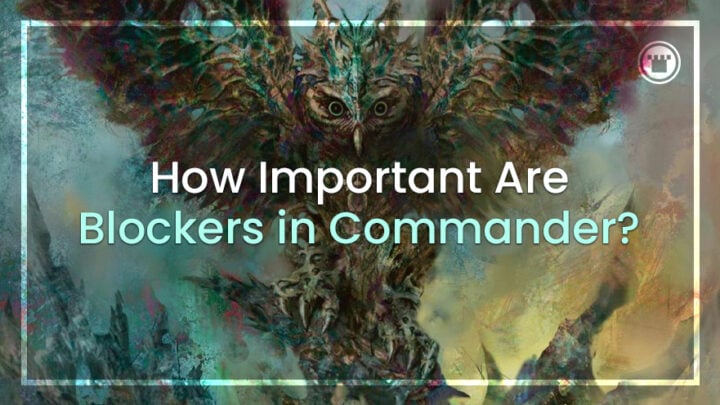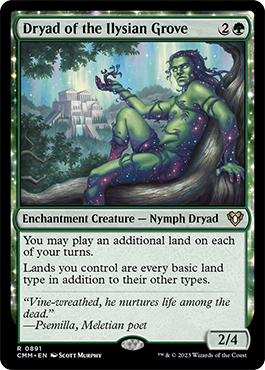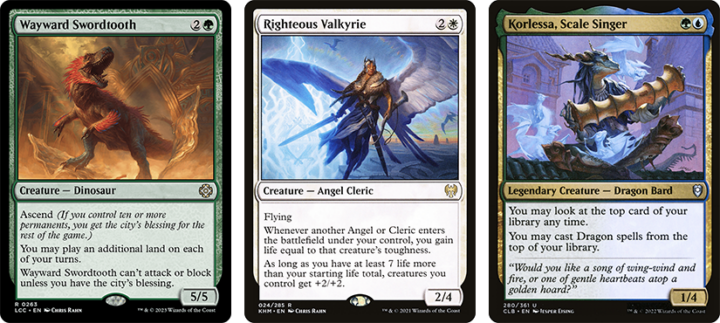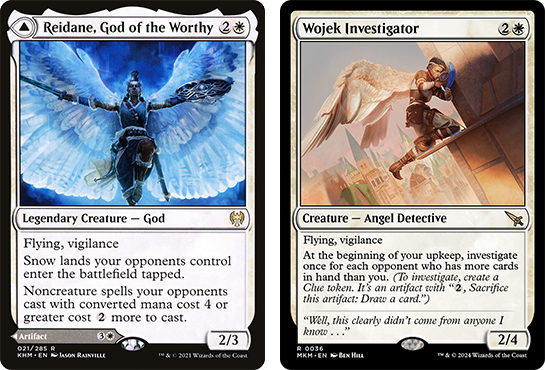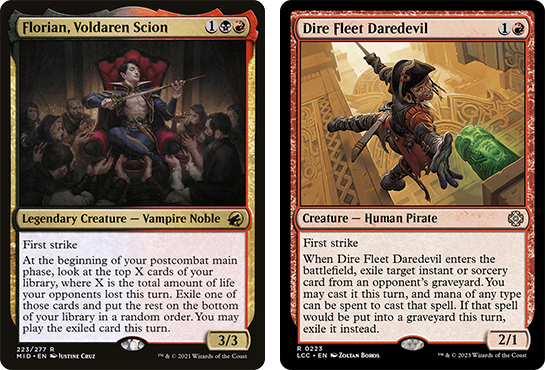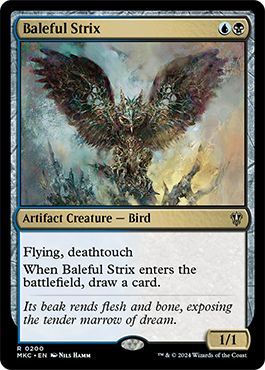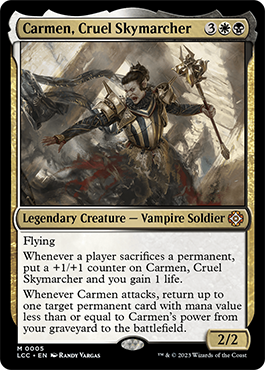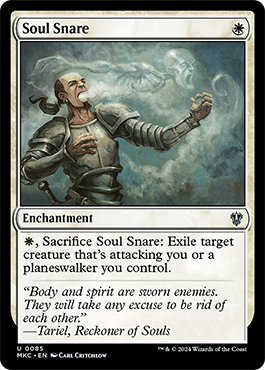Kristen has some thoughts on how a good blocker is more important than ever in Casual Commander.
In short, blockers are good. Play more of them!
That’s not why you clicked, though – you’re more interested in my reasoning. So let’s just jump straight in.
THE STATE OF CASUAL COMMANDER
Casual Commander in 2024 is in a good place, but it isn’t without its flaws (which I cover in my 2024 Commander Wishlist). Despite that, it remains a fun and interesting game, and even with the overall metagame speeding up and feeling way more consistent, there’s still plenty of agency and interaction to be had.
Commander Precons are the rising tide that raises all ships, and they’re setting a new bar when it comes to the average power of a deck. Precons are deliberate, they have synergy, and they don’t pull punches. Hell, some of them have infinite combos in, whether accidental or not!
Mana curves have never been lower, and while Commander started as a format to play all of the six, seven or eight mana creatures you don’t get to play anywhere else, they’re often now relegated to big mana or reanimator decks, outside of a couple of curve toppers. The “midrange” deck now has more four and five drops, and aggro decks have been given a real shot in the arm.
TURN SIDEWAYS
What Wizards has pushed with card design in the past few years is to always be turning creatures sideways. As Tom covered in his recent article on the Commander War Economy, going to combat and taking extra combats has never been more lucrative. Attack triggers, combat damage triggers, damaging a player – everything generates value now, whether that’s cards, treasures, or more powerful triggers still.
As such, chip damage is inevitable, and players have never been more free with their attacks. I personally welcome this change, as sitting behind a wall of tokens and midrange creatures while not attacking is boring, and it was always Simic players who would do it. Crusty Simic players.
Instead, you’re going to be taking hits early, and you’re going to have to like it. Especially if those hits are of two or three damage – it’s preferable to take those than the “love taps” of five or six damage that come on the following turns.
There are still decks that generate value without needing to rely on combat so much, but even then, you’re going to want to attack into those decks anyways because you’ll either force blocks or get free damage.
LIFEGAIN IS GREAT
Lifegain, Vigilance and Menace won out when I talked about the Best Keywords in Commander recently. Being able to tank damage and survive to the mid to late game is essential to converting a win in decks that usually win through combat damage.
Vigilance and Menace are ways to make combat easier for you, and both revolve around who has blockers. Blockers are very important in Casual Commander (and still good in cEDH, actually).
The fact that Menace has been good lately indicates that people just aren’t playing enough good blockers. Whether that’s because they don’t deploy enough creatures, or make any tokens, or because they are also swinging out and attacking regularly, makes little difference. What’s key here is to understand why Menace and Vigilance have gotten better, and then course correct.
BLOCKERS ARE GOOD, ACTUALLY
While blockers historically have always been about preserving life totals, in modern era Commander, blockers also allow us to deny opponents the opportunity to profit from combat. If we can make ourselves unassailable, we can not only survive long enough to try and win, but also slow down our opponents. Without the extra cards and treasures gained from combat triggers, their consistency falls, and if we can put out some strong deterrents, we may even halt Commander damage or tempo-shifting triggers like reanimation.
Big butts are in right now, and the poster child for this movement is Dryad of the Ilysian Grove. A good few years back when this released, a lot of comments were made about it being so powerful that it didn’t need to be a 2/4 as well; it could have been a 2/3 or even a 2/2.
Toughness four is the sweet spot, and thought you’re most likely to see this statline within the Bant part of the pie, it’s available in all colors at three mana or less.
Even in a few years, we’ve gone from a 2/3 with Flying and Vigilance to a 2/4 for the same mana cost. These creatures are quickly becoming more useful as ways to shut down incoming attackers.
The thicc booty isn’t the only way to intercept an attack. Utility creatures with First Strike make for excellent blockers too, with a lot of the formats most popular attackers that generate value going down to a hit from a two or three power creature. Professional Face-breaker, Ragavan, and most tokens that want to get value from Enchantments in play can fall to First Strike.
First Strike is also good when combined with Deathtouch.
OWL ALWAYS LOVE THE STRIX
Baleful Strix remains one of the most popular creatures in the format thanks to its ability to trade with basically anything, get in with evasion for triggering abilities, and the fact it replaces itself when you play it.
In my roundup of the best keywords in the format, Deathtouch kinda got a bad rap. I said it had dropped off a little, and while I think that it hasn’t enjoyed as many gains as Lifegain and Vigilance, I think I was a little harsh. It still has a big place in the format – even with the sheer quantity of token creatures making its ability to trade less valuable.
I recently built Carmen, and it was a hoot to play. I did have some close calls with huge Managorger Hydras, though, who took advantage of my deck’s fewer blockers and investment in a single big attacker. While the lifegain in my deck helped me to survive long enough until I drew removal, I did take some lessons from that game, and that was to play some more deathtouch blockers.
I slotted in Vile Entomber, because it’s on my game plan, and Ayli, who is infinitely better in the 99 when she can come down out of nowhere than when she’s telegraphed in the Command Zone. Both actively help me do what I want to do – reanimate stuff and sacrifice stuff – while being roadblocks for my opponents.
Consider if you can staple an effect you already want onto a Deathtouch creature. I usually run Skullwinder over Eternal Witness these days because not only do I like fun and politics, but I also like having sweet blockers.
Shoutout to Soul Snare too – rattlesnake effects are solid, as ever.
END STEP
Casual Commander is a format that revolves around doing damage to gain value. Chip damage is encouraged by Wizards, and I’ve written in the past about how the player who is behind doesn’t necessarily get left alone anymore; they’re a punching bag that spits out cards and mana to enable the players catching up to the archenemy to destroy them. Instead of being a neutral third party, you’re more often going to end up as collateral damage.
Play some blockers, chumps.

Kristen is Card Kingdom’s Head Writer and a member of the Commander Format Panel. Formerly a competitive Pokémon TCG grinder, she has been playing Magic since Shadows Over Innistrad, which in her opinion, was a great set to start with. When she’s not taking names with Equipment and Aggro strategies in Commander, she loves to play any form of Limited.

